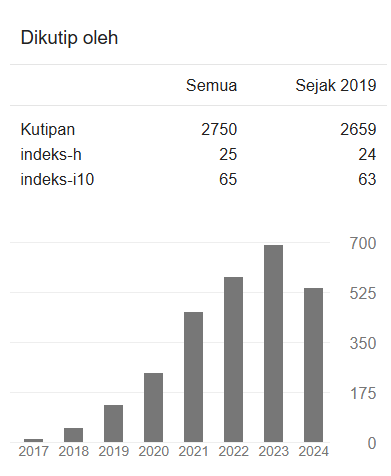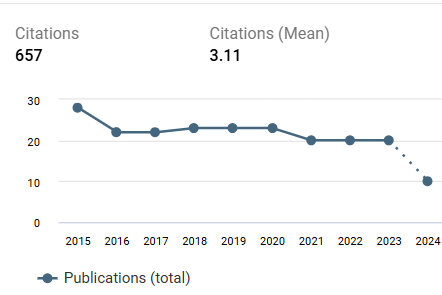Development of interactive e-modules with stem approach using canva application to improve students' critical thinking ability in physics learning
DOI:
https://doi.org/10.22219/jinop.v10i2.32004Keywords:
Critical Thinking Skills, Digital Interactive E-Modules, STEM ApproachAbstract
This study aims to determine the feasibility, response, and improvement of students' critical thinking skills towards learning using e-modules. This type of research is development research using Sugiyono's development model with 10 stages, namely potential and problems, data collection, product design, design validation, design revision, product trials, product revisions, usage trials, final product revisions, and mass production. The research was conducted at SMPN 6 Krui and MTsN 2 Lampung Tengah, with the research subjects being 88 students in class VIII. The instruments used in this study were validation sheets, student response questionnaire sheets and critical thinking ability tests. Based on the results of the study, the validation results of interactive e-modules with the STEM approach from material experts amounted to 92% and media experts amounted to 90% with the category very feasible to use in learning. The response of students to the attractiveness of the e-module in the field trial was 90% and the educator was 89% with a very interesting category. The results of improving students' critical thinking skills obtained N-gain 0.71 including the high category. Thus the e-module developed is categorized as feasible to use as an alternative physics teaching material
Downloads
References
Ayuardini, M. (2022). Pengembangan E-Modul Interaktif Berbasis Flipbook pada Pembahasan Biologi. Journal LPPM Unindra, 15(4). https://doi.org/10.30998/faktorexacta.v15i4.14924
Aziza, Syaila Amilyana, Tjandra Kirana M. Sjaifullah Noer, & Raharjo. (2021). A Teaching Material Based on Science, Environment, Technology, and Society to Improve Student’s Critical Thinking Skills: Synchronous and Asynchronous Learning During Covid-19 Pandemic. IJORER : International Journal of Recent Educational Research, 2(4), 372–391. https://doi.org/10.46245/ijorer.v2i4.109
Das, P. M. (2018). Cultivating Critical Thinkers : Strategies for Developing Analytical Minds. International Journal of Research and Analytical Reviews (IJRAR), 5(4), 576–584.
Diani, R., & Syarlisjiswan, M. R. (2018). Web-enhanced course based on problem-based learning ( pbl ): development of interactive learning media for basic physics ii. Jurnal Ilmiah Pendidikan Fisika Al-BiRuNi, 07(April), 105–116. https://doi.org/10.24042/jipfalbiruni.v7i1.2849
Evenddy, S. S., & Gailea, N. (2024). Implementation of E-Module in Indonesia EFL Higher Education : A Literature Review. IJORER : International Journal of Recent Educational Research, 5(5), 1174–1185. https://doi.org/10.46245/ijorer.v5i5.688
Fauzi, R., & Hayya, A. W. (2022). Pengembangan E-Modul Interaktif Berbasis STEM pada Topik Ekologi SMA ( Development of STEM-Based Interactive E-Module on Ecology Topic for Senior High Schools ’ Student ) Metode. Indonesian journal of biology education, 5(2), 80–88. https://doi.org/10.17509/aijbe.v5i2.44785
Herispon, H. (2020). Statistical Package for the Social Sciences ( SPSS ) Panduan Pengolahan Data Penelitian Menggunakan SPSS 23 Bagi Mahasiswa HERISPON Sekolah Tinggi Ilmu Ekonomi Riau Pekanbaru , 2020. July, 1–45.
Izzati, N. R. T., Susanti, & Siregar, N. A. R. (2019). Pengenalan Pendekatan STEM sebagai Inovasi Pembelajaran Era Revolusi Industri 4.0. Jurnal Anugerah, 1(2), 83–89. https://doi.org/10.31629/anugerah.v1i2.1776
Jamaludin, J., Kakaly, S., & Batlolona, J. R. (2022). Critical thinking skills and concepts mastery on the topic of temperature and heat. Journal of Education and Learning (EduLearn), 16(1). https://doi.org/10.11591/edulearn.v16i1.20344
Khoiriyah, N., & Wahyudi, I. (2018). Implementasi pendekatan pembelajaran STEM untuk meningkatkan kemampuan berpikir kritis siswa SMA pada materi gelombang bunyi. 5(1), 53–62.
Kurniawan, A. R., Budiono, H., Hariandi, A., Marlina, M., Kurniawati, E. F., Meidiawati, R., & Piyana, S. O. (2020). Investigasi Minat Belajar Terhadap Modul Elektronik Berbasis Etnokontruktivisme. Profesi Pendidikan Dasar, 1(1), 93–104. https://doi.org/10.23917/ppd.v1i1.10650
Lastri, Y. (2023). Pengembangan dan pemanfaatan bahan ajar e-modul dalam proses pembelajaran. Jurnal Citra Pendidikan (JCP), 3, 1139–1146. https://doi.org/10.38048/jcp.v3i3.1914
Latifah, Nurul, A., & Kurniawanhari, E. S. (2020). Pengembangan e-Modul Fisika Untuk Meningkatkan Kemampuan Berpikir Kritis Peserta Didik Nurul. JIPS: jurnal inovasi pendidikan sains, 01, 1–7. https://jurnal.umpwr.ac.id/index.php/jips
Liu, Y., & B, L. F. (2023). Research on Hybrid Teaching of Curriculums Based on the ADDIE Model. Atlantis Press SARL. https://doi.org/10.2991/978-2-38476-018-3
Lukitoyo, N. P. S., & Wirianti, W. (2020). Modul Elektronik: Prosedur Penyusunan dan Aplikasinya. Yayasan Kita Menulis.
Muchlis, L. N., & Yunus, S. R. (2023). Pengembangan e-modul interaktif berbasis canva untuk meningkatkan minat baca dan hasil belajar peserta didik pada materi sistem ekskresi. Jurnal Ipa Terpadu, 7(2), 294–304. http://ojs.unm.ac.id/index.php/ipaterpadu%0Ap-ISSN
Mulyono, Dodik, E. A. (2023). E-Modul Interaktif Teori Bilangan Menggunakan Aplikasi Kvisoft Flipbookmaker. JINoP ( Jurnal Inovasi Pembelajaran ), 9(c), 70–81. https://doi.org/10.22219/jinop.v9i1.20584
Noperi, H., & Sarwanto, S. (2021). Pengembangan modul ilustratif berbasis inkuiri terbimbing bermuatan pendidikan karakter. SPEJ (Science and Phsics Education Journal), 4(September), 70–81.
Nurissamawati, B., Yuniawatika, & Mas’ula, S. (2024). E-module development using problem-based learning approach to learn data processing in training students’ critical thinking. Jurnal Inovasi Pembelajaran, 10(1), 62–79. https://doi.org/https://doi.org/10.2221 9/jinop.v10i1.28626
Oktariani, Baruri, A., & Saputri, E. R. (2024). Development of science, technology, engineering, and mathematics (STEM) based chemistry e-module learning materials on the topic of reaction rate of learning. Jurnal Inovasi Pembelajaran, 10(1), 115–129. https://doi.org/10.22219/jinop.v10i1.29103
Permana, I., & Kurniasih, S. (2021). Efektivitas E-Modul Sistem Pencernaan Berbasis Problem Solving Terhadap Kemampuan Pemecahan Masalah Pendahuluan. Jurnal IPA Dan Pembelajaran IPA, 5(1), 36–47. https://doi.org/10.24815/jipi.v5i1.18372
Prawita, W., Maret, U. S., Prayitno, B. A., & Maret, U. S. (2019). Effectiveness of a Generative Learning-Based Biology Module to Improve the Analytical Thinking Skills of the Students with High and Low Reading Motivation Effectiveness of a Generative Learning-Based Biology Module to Improve. International Journal of Instruction, January. https://doi.org/10.29333/iji.2019.12193a
Prameswari, Salvina, Wahyu, Suharno, S. (2018). Inculcate critical thinking skills in primary schools. 1(Snpd), 742–750. https://jurnal.uns.ac.id/shes
Rahmawati, M., T, A. Y., Sayu, S., Fitriawan, D., Suratman, D., Bs, A., Matematika, P., & Kependidikan, F. (2022). Pengembangan media pembelajaran teorema phytagoras menggunakan e-. Jurnal Penelitian Matematika Dan Pendidikan Matematika, 6, 155–163. https://doi.org/10.30605/proximal.v6i1.2086
Saputra, H. (2020). “ Kemampuan Berfikir Kritis Matematis .” “Kemampuan Berfikir Kritis Matematis,” April, 1–7.
Seruni, R., Munawaroh, S., Kurniadewi, F., & Nurjayadi, M. (2019). Pada materi metabolisme lipid menggunakan flip pdf professional. JTK: Jurnal Tadris Kimiya, 1(Juni), 48–56. http://dx.doi.org/10.15575/jtk.v4i1.4672
Shabrina, A., & Diani, R. (2019). Pengembangan Media Pembelajaran Fisika Berbasis Web Enhanced Course dengan Model Inkuiri Terbimbing. Indonesian Journal of Science and Mathematics Education, 2(1), 9–26. https://doi.org/10.24042/ijsme.v2i1.3922
Sholeh, B., Hufad, A., & Fathurrohman, M. (2023). Pemanfaatan E-Modul Interaktif dalam Pembelajaran Mandiri Sesuai Kapasitas Siswa. Risalah, Jurnal Pendidikan Dan Studi Islam, 9(2), 665–672. http://jurnal.faiunwir.ac.id/index.php/Jurnal_Risalah/article/view/458
Sholeh, M., & Susanti, E. (2020). Penggunaan aplikasi canva untuk membuat konten gambar pada media sosial sebagai upaya mempromosikan hasil produk ukm. Jurnal Pengabdian Masyarakat Berkemajuan, 4(November), 430–436.
Sugiyono. (2013). metode penelitian kuantitatif kualitatiff dan R&D (Sugiyono (ed.)).
Susanti, R. D., & Ummah, S. K. (2021). Pengembangan bahan ajar open-ended melalui polysynchronous learning berbantuan canvas. JINoP ( Jurnal Inovasi Pembelajaran ), 7(November), 115–128. https://doi.org/10.22219/jinop.v7i2.15043
Wahdaniyah, N., Agustini, R., & Tukiran, T. (2023). Analysis of Effectiveness PBL-STEM to Improve Student’s Critical Thinking Skills. IJORER : International Journal of Recent Educational Research, 4(3), 365–382. https://doi.org/10.46245/ijorer.v4i3.312
Wenno, I. H., Limba, A., Greintje, Y., & Silahoy, M. (2022). The development of physics learning tools to improve critical thinking skills. International Journal of Evaluation and Research in Education (IJERE), 11(2), 863–869. https://doi.org/10.11591/ijere.v11i2.21621
Wulandari, F., Yogica, R., & Darussyamsu, R. (2021). Analisis Manfaat Penggunaan E-Modul Interaktif Sebagai Media Pembelajaran Jarak Jauh Di Masa Pandemi Covid-19. Khazanah Pendidikan, 15(2), 139. https://doi.org/10.30595/jkp.v15i2.10809
Yudha, C. B. (2019). Terhadap kemampuan berpikir kritis mahasiswa. 9, 31–36.
Yulianti, D. (2024). Development of a science , environment , technology , and society- based learning module to foster critical thinking in elementary students. Journal of Education and Learning (EduLearn), 18(4), 1372–1384. https://doi.org/10.11591/edulearn.v18i4.21713
Yunida, I., Husna, A., & Masykuri, M. (2021). Development of Instructional Module Based on Inquiry-Interactive Demonstration to Improve Students ’ Critical Thinking Skills. JIPF (JURNAL ILMU PENDIDIKAN FISIKA), 6(1), 66–75. https://doi.org/DOI: 10.26737/jipf.v6i1.1840
Yusuf, I., Ma’rufi, & Nurdin. (2022). Pendekatan STEM untuk Meningkatkan Kemampuan Berpikir Kritis dan Motivasi Belajar Siswa pada Pembelajaran Matematika. Jurnal Riset HOTS Pendidikan Matematika, 2, 26–40. https://doi.org/10.51574/kognitif.v2i1.416
Zeid, I., & Chin, J. (2014). Engineering Based Learning : A Paradigm Shift for High School STEM. June 2015.
Zubaidah, S. (2018). Asesmen Berpikir Kritis Terintegrasi Tes Essay Asesmen Berpikir Kritis Terintegrasi Tes Essay. April 2015.
Downloads
Published
How to Cite
Issue
Section
License
Copyright (c) 2024 Yunita et al

This work is licensed under a Creative Commons Attribution 4.0 International License.
Copyright Notice
Authors who publish with JINoP (Jurnal Inoasi Pembelajaran) agree to the following terms:
- For all articles published in the JINoP (Jurnal Inovasi Pembelajaran), copyright is retained by the authors. Authors give permission to the publisher to announce the work with conditions. When the manuscript is accepted for publication, the authors agree to the automatic transfer of the publishing right to the publisher.
- Authors retain copyright and grant the journal the right of first publication with the work simultaneously licensed under a Creative Commons Attribution 4.0 International License. that allows others to share the work with an acknowledgment of the work's authorship and initial publication in this journal.
- Authors are able to enter into separate, additional contractual arrangements for the non-exclusive distribution of the journal's published version of the work (e.g., post it to an institutional repository or publish it in a book), with an acknowledgment of its initial publication in this journal.
- Authors are permitted and encouraged to post their work online (e.g., in institutional repositories or on their website) prior to and during the submission process, as it can lead to productive exchanges, as well as earlier and greater citation of published work (See The Effect of Open Access).








